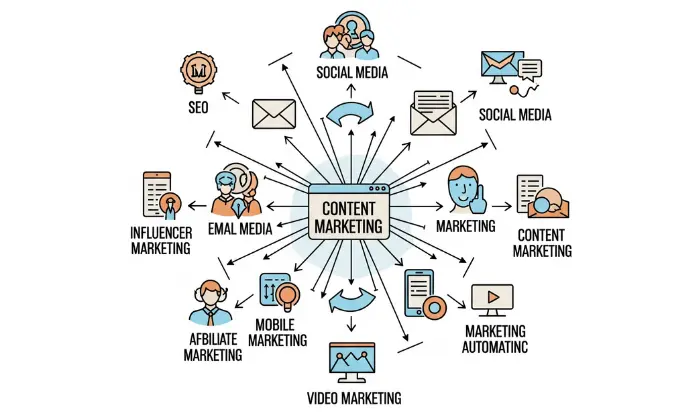Why Marketing Has Evolved
Marketing is no longer just about advertising. It’s about deeply understanding people — their needs, desires, habits — and matching them with products or services that solve real problems. And in today’s digital age, how we deliver that value has drastically changed.
Two decades ago, businesses relied on radio, TV, newspapers, and word of mouth. These were effective but lacked precision — you couldn’t tell who saw your ad or whether it converted. But now, digital marketing channels give us tools to track, target, and optimize everything.
What Are Marketing Channels in Digital Marketing?
Marketing channels are the platforms or methods businesses use to deliver their message to the right audience. In digital marketing, these channels are online — allowing businesses to connect, engage, and convert users in real time.
10 Essential Digital Marketing Channels (with Examples)
1. Search Engine Optimization (SEO)
What it is: Optimizing content so it appears on top of Google or Bing search results.
Example: Someone searches “best protein powder.” If your blog ranks high, they visit your site and potentially buy.
Why it matters: Brings in free traffic, builds trust, and works 24/7.
2. Search Engine Marketing (SEM) / Pay-Per-Click (PPC)
What it is: Running paid ads on Google or Bing that appear when someone searches keywords.
Example: A language learning app in Berlin promotes via Google Ads like “learn German fast.”
Why it matters: Immediate visibility, highly measurable, and budget-flexible.
3. Social Media Marketing
What it is: Using platforms like Instagram, LinkedIn, X (Twitter), and Facebook to build communities and promote content.
Example: A Toronto-based boutique responds to Instagram DMs and closes sales within minutes.
Why it matters: People already spend hours here. Brands meet them where they are.
4. Email Marketing
What it is: Sending emails to subscribers about offers, tips, or updates.
Example: An eCommerce store sends “back-in-stock” emails that drive instant purchases.
Why it matters: It’s direct, personal, and has the highest ROI of any digital channel.
5. Content Marketing
What it is: Creating blogs, videos, infographics, and guides that educate or entertain.
Example: A blog on “Top 5 Backpacks Under $50” leads to affiliate sales on Amazon.
Why it matters: Builds trust and drives long-term traffic.
6. Influencer Marketing
What it is: Collaborating with creators or influencers to promote your brand.
Example: A YouTuber reviews your travel backpack — leading to direct purchases from fans.
Why it matters: Combines social proof + audience reach.
7. Affiliate Marketing
What it is: Letting partners promote your products and earn a commission.
Example: Bloggers list your product on “Best Tools” lists with their custom link.
Why it matters: You only pay when you get results.
8. Mobile Marketing
What it is: Reaching users through mobile apps, push notifications, and SMS.
Example: A fitness app sends a 10% off code via push notification.
Why it matters: Mobile is where attention lives. Instant and personal.
9. Video Marketing
What it is: Using platforms like YouTube, Reels, and TikTok to inform or sell via video.
Example: A review video on YouTube explains your product in action — building trust instantly.
Why it matters: High engagement, emotional impact, and visual storytelling.
10. Marketing Automation
What it is: Using tools to automatically send emails, ads, or content based on user behavior.
Example: A customer abandons cart — they get a 15% off email 2 hours later, automatically.
Why it matters: Scales your marketing without scaling effort.
How These Channels Work Together
Today’s buyers don’t take a straight path. Here’s a real-world timeline:
- 8 AM: Scrolls past a travel backpack ad on Instagram
- 12 PM: Googles “best travel backpacks under $50”
- 4 PM: Reads a blog comparing backpacks
- 7 PM: Watches a YouTube review
- 9 PM: Buys via Amazon suggestion
This journey involves 5 channels — and happens in just one day. That’s the power of an integrated marketing strategy.
Omnichannel Is the Future
Modern digital marketing isn’t about picking one channel — it’s about orchestrating many. When channels work together:
- SEO brings people in
- Email keeps them engaged
- Social builds community
- Ads amplify reach
- Video tells your story
With tools like AI, automation, and analytics, even small businesses can compete with big brands — smartly and affordably.
Conclusion: Start Small, Think Big
You don’t need to master every channel on Day 1. Start where your audience is. Learn how channels connect, and build gradually.
Whether you’re launching a brand, freelancing, or just exploring digital marketing — knowing your marketing channels is the first big step.
Stay tuned as we dive deeper into each one — from strategy to tools, and real-world campaigns.
Find out article related to Top 10 AI Tools for Digital Marketers
